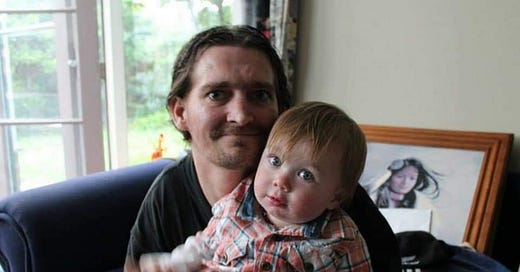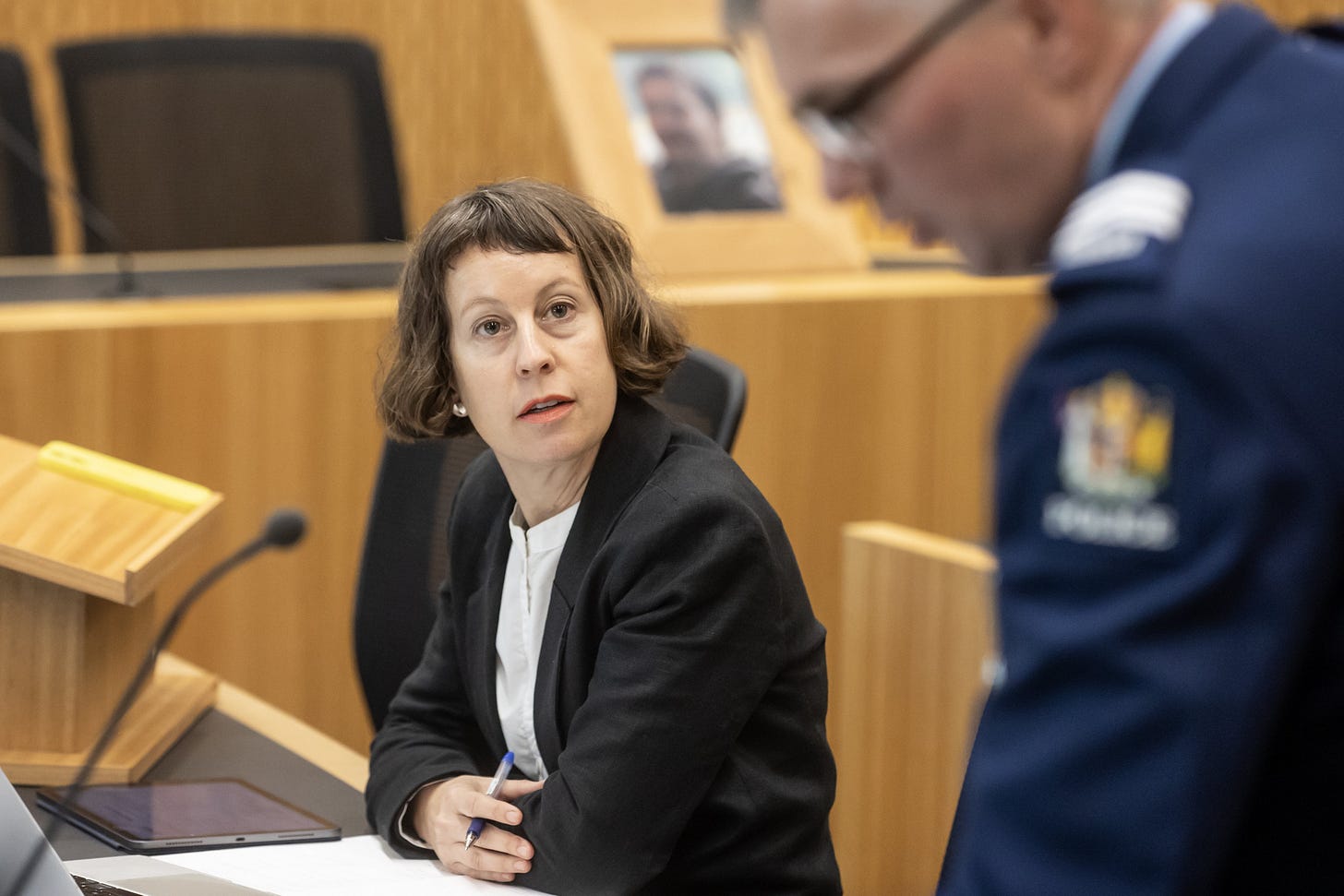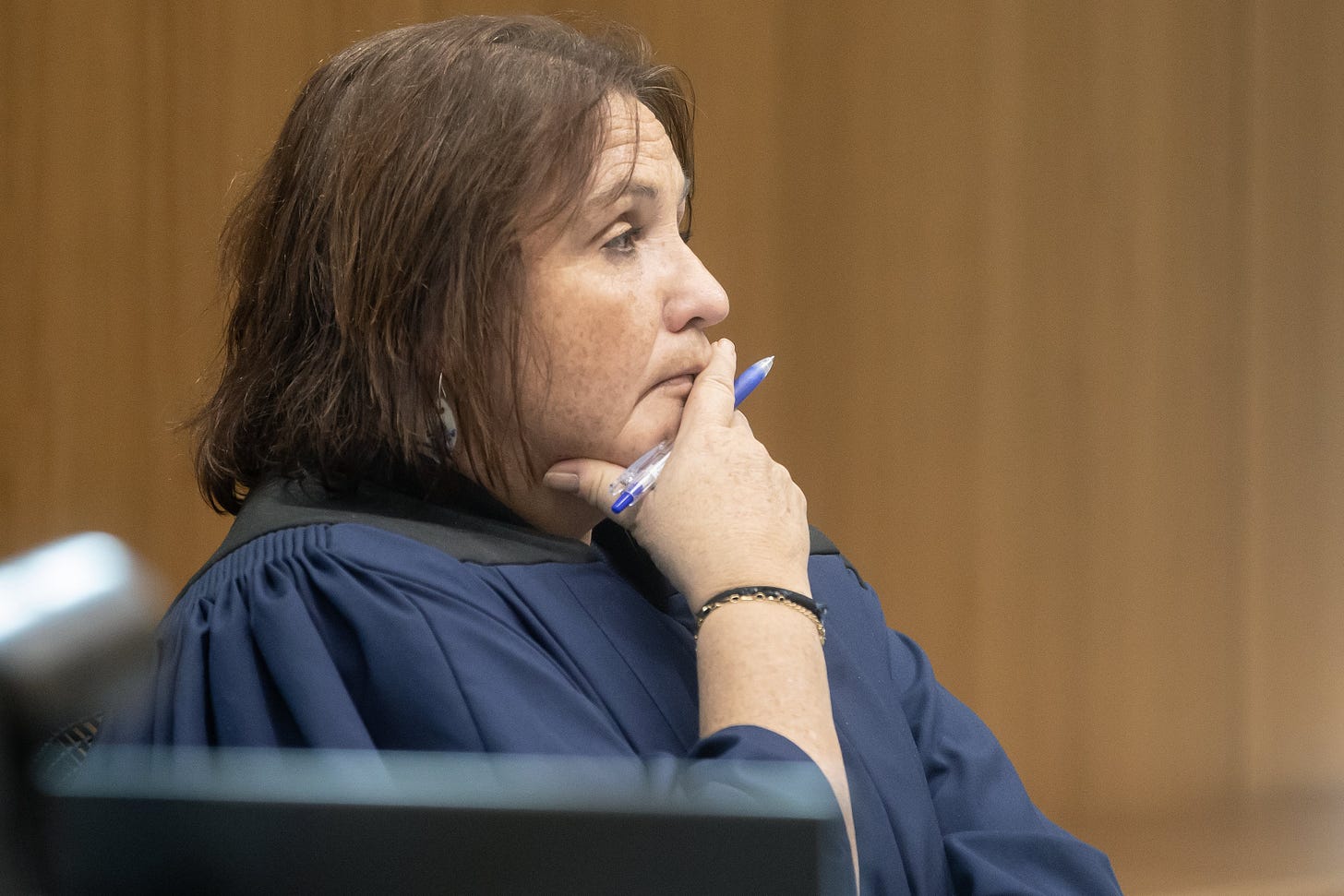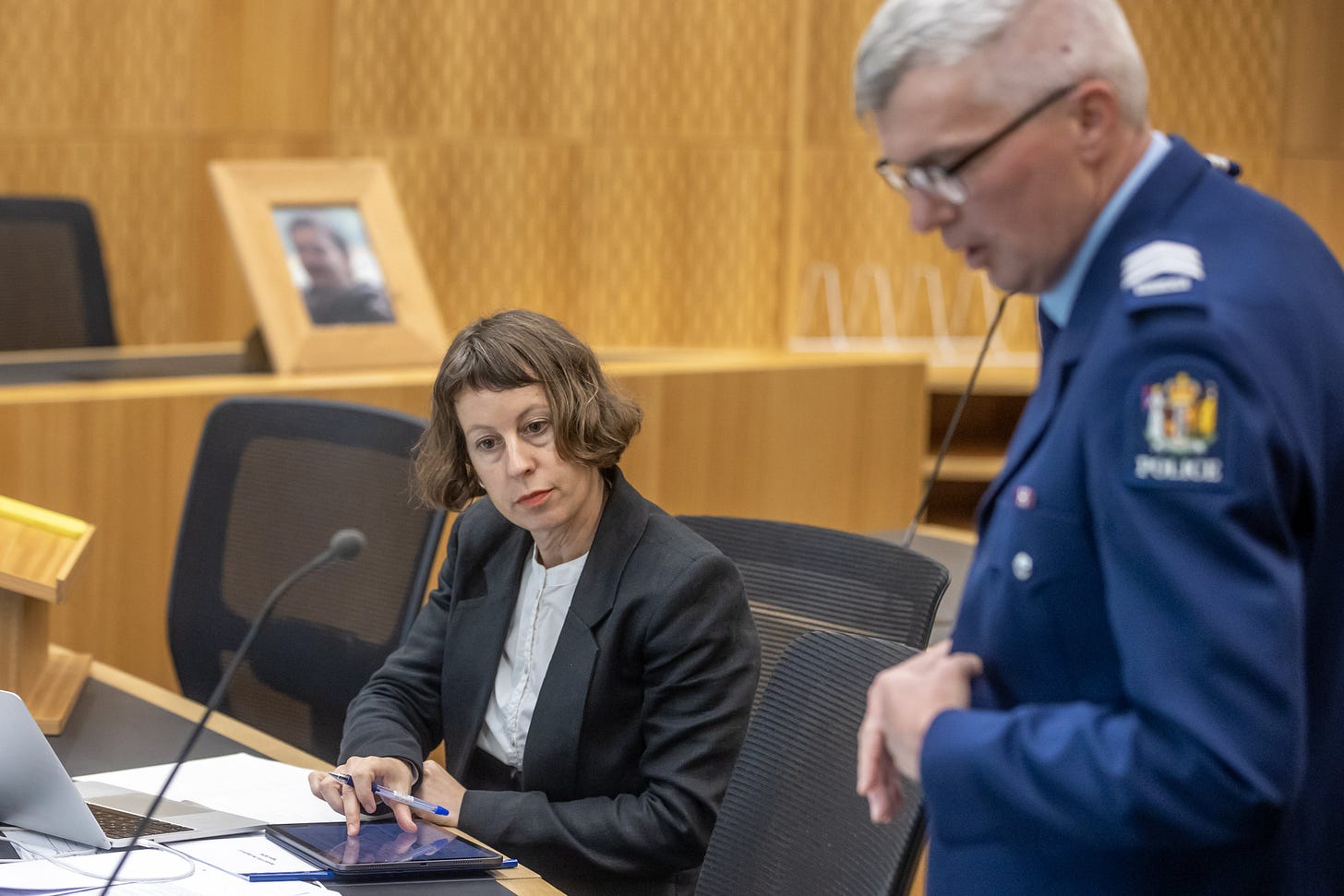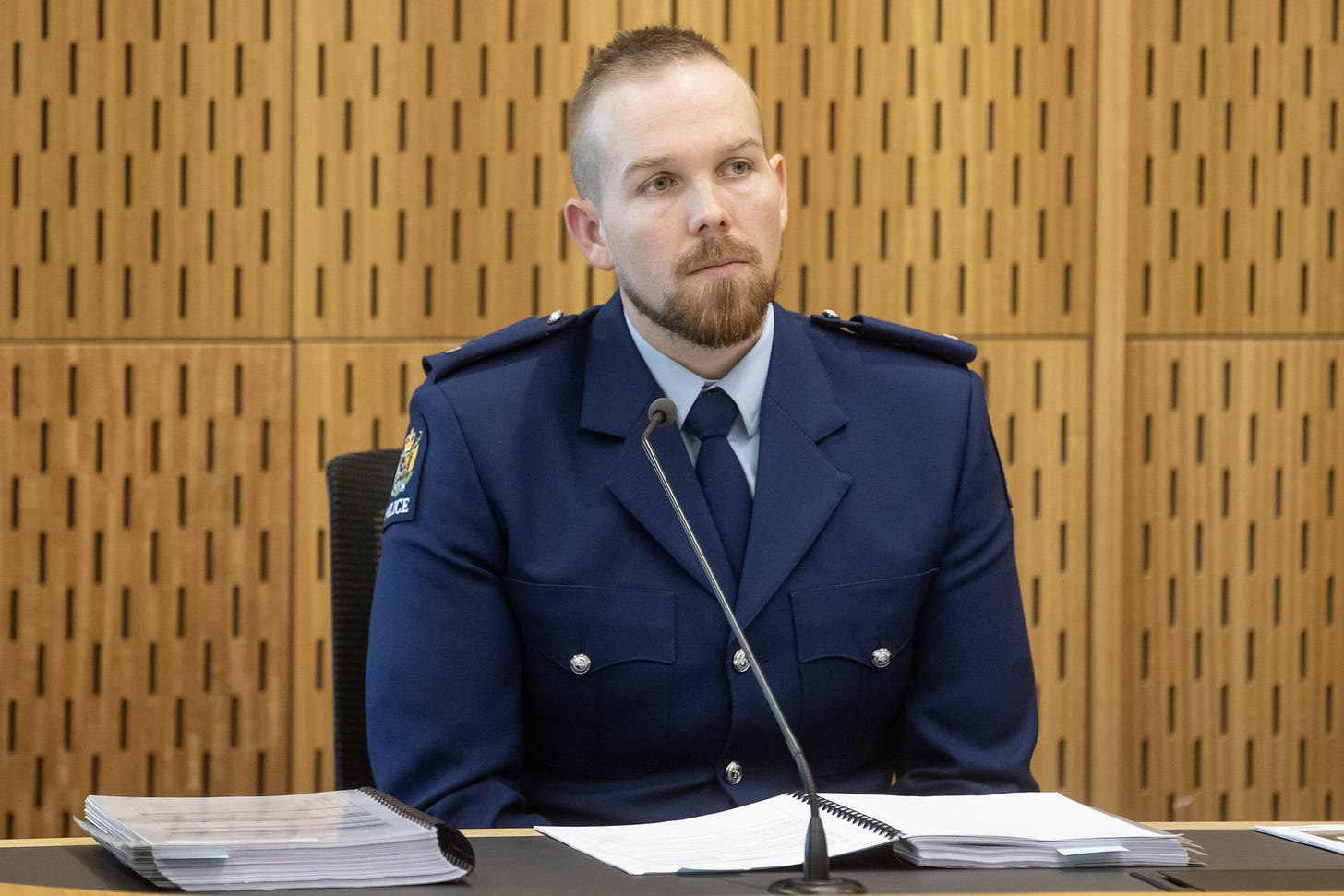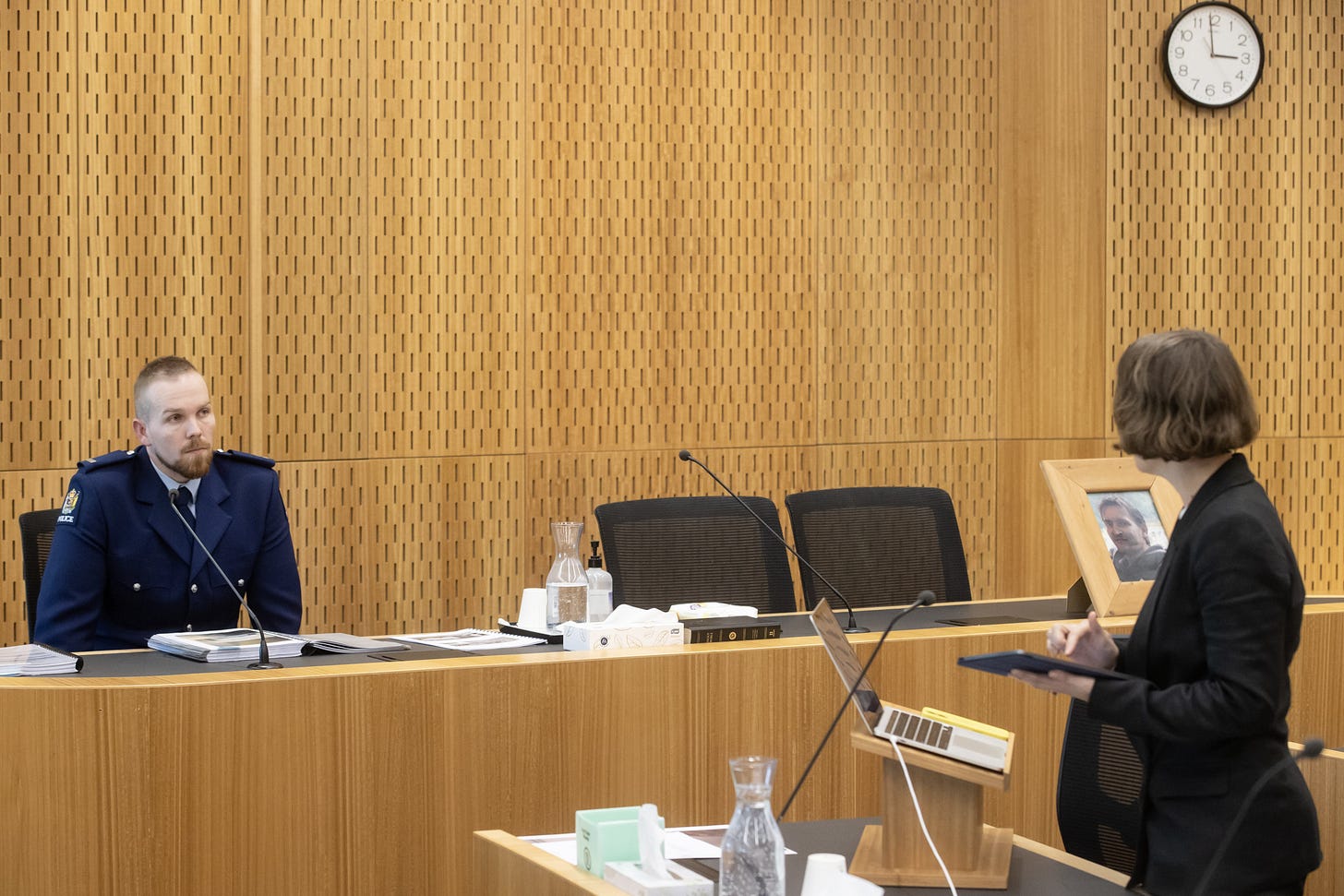Litany of Police Errors and Finger Pointing: The Nigel Bom Inquest (Day Three)
23 May 2025. The New Zealand Reporter. The NZR digs deep into the Nigel Bom inquest of 5 to 9 May 2025. Updated to 26 May 2025.

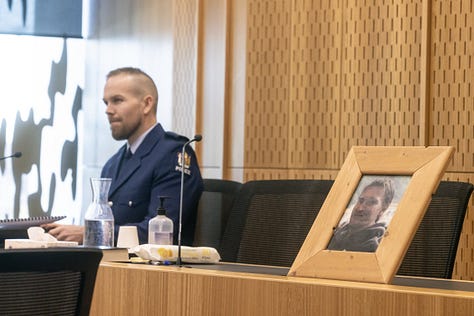
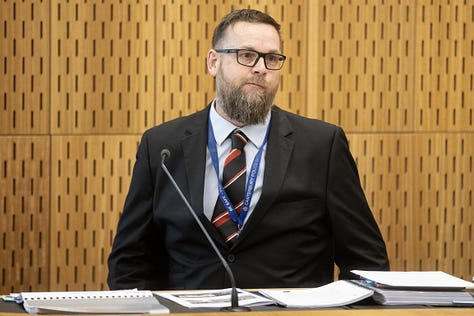
Day three saw an array of Police witnesses and tenants (either former or present) give testimony in the Coroner’s inquest into the death of Nigel Bom of March 2021.
Not all of the evidence would fit neatly together and Police admitted to a slew of errors, ranging from not photographing and keeping evidence to an officer being stood down when a statement from a key neighbour was about to be taken.
Note: Tenant E lived in Fred Price Courts from time to time but does not appear to be a contracted tenant.
Tenant G - Fred Price Courts Tenant
Day 3 began with Tenant G giving evidence via video link.
Day 2 witness Neighbour X had given evidence he had secretly recorded Tenant G in his car on 15 July 2021 regarding Nigel Bom’s supposed murder.
Tenant G told the inquest Tenant E and Tenant A had given Bom morphine. This was a rumour that had been relayed to her by a woman called [redacted].
Bom had never had morphine before, she said. She didn't know whether they [or one of them] were "“fucking” with me.
Police told her Neighbour X had recorded her.
Police Officer Y (2009- )
Lucila van Dam, counsel to assist the Coroner, Rachael Schmidt-McCleave. Credit: Iain McGregor/The Press.
On 30 March 2021, Police Officer Y went to Fred Price Courts at 12 noon, after the OCHT tenancy manager had done a welfare check on Bom's unit.
At the time of the callout, Police Officer Y was a field supervisor at Papanui station with the rank of sergeant. He was in charge of 6-10 staff but Constable Scown and Collany (, who later played crucial role in how the crime scene and evidence were handled) were working out of the central station, and were sent at his request.
Police Officer Y believed the Police communications centre probably told him about Bom and that he "had minimal information...but enough". He was unsure whether the welfare check would involve a dead person.
At the flat he spoke to the tenancy manager, who advised him that Bom had not been seen for several days and that she was there to do welfare check. Police Officer Y smelt something and saw flies inside.
She gave him the master key to enter his flat. Police Officer Y recalled the door was locked; he couldn't recall the type of lock and didn't find a key.
Police Officer Y entered a small room and walked in three or so meters. There was a bed on his right, in front of the doorway. He walked closer and immediately saw a person lying under a blanket with his head away from the door. He observed him from above. Police Officer Y couldn't recall seeing feet.
He could tell it was person in that bed. His only recollection, which was confirmed by counsel to the coroner Schmidt-McCleave, was that there was a "mass inside".
Having found a body, Police Officer Y walked out of the unit and advised the tenancy manager and Police communications of a sudden death. He couldn’t recall whether he contacted Close Associate A.
Police Officer Y called for a Police unit and a central incident car was sent to the location. He believed the male was likely to be Bom and understood he had a history of severe epilepsy.
He asked for assistance and sought a statement from last person to see him alive.
Police Officer Y learned that another person was seeking to advise Close Associate A of his death, so he asked for a unit to get there first. Detective Macpherson, (who would give evidence later on day 3) did not think the circumstances of his death were suspicious.
Coroner Rachael Schmidt-McCleave/ Credit: Iain McGregor/The Press.
A Disaster (Verification) Identification Team came in, said Police Officer Y, and Bom was photographed by the duty photographer Charlotte Dindal. Police Officer Y later spoke to a person, whom told him the family believed he was murdered.
Of the Neighbour X’s voice recording that spoke of someone killing Bom, he listened to it, but concluded he only heard someone speculating that another person had killed him. Police Officer Y was told the family believed Bom's death was not due to natural causes.
"[There was] nothing that led you to believe...[it was] suspicious," van Dam asked Police Officer Y. He agreed. You look for signs of a scuffle, trauma, etc, he responded. Bom's body was completely covered.
Police Officer Y admitted to pulling back the cover but couldn't recall doing it. Underneath he saw "Nigel's head". He couldn't remember putting the blanket back over Bom. It was possible he didn't cover the entire head.
Van Dam asked whether it was normal to move something at a scene? He felt he needed to "observe Nigel," he responded, and thought it possible he moved the blanket to protect Bom's dignity.
Police Officer Y says he did not look at the body. So, it was pointed out by van Dam, he would not have seen any stab wounds.
He also did not recall seeing position of Bom's arms but he did not see the positioning as suspicious, because "people sleep in a number of different ways". Bom's body had been found with his "arms folded in front of him", said van Dam. He didn't find that suspicious.
Police Officer Y had been to several sudden deaths. The fact the blanket had completely covering head was not necessarily suspicious. Some people might sleep entirely under blanket, he surmised.
When Police Officer Y went into the room, he believed knew Bom had epilepsy after been spoken to by the tenancy manager.
Van Dam asked Police Officer Y about the Police Checklist for dealing with sudden deaths.
Police Officer Y admitted he didn't often use the checklist, because he understood "what I need to do at the incidents"; he would take steps and direct the team.
Van Dam said Police Officer Y didn't do a scene examination. Rather, according to his statement, he called unit to assist and tasked them call to the coroner and find the last person to see Bom alive. Finding that last person, involved speaking to people, knocking on doors, etc, said Police Officer Y. And doing this until the last person was found. Once that person was found, a statement would be taken, he told the inquest.
But that didn't happen. This chapter of the Bom inquest raised a question that would not be resolved following a procession of Police witnesses: who was ultimately in charge of the scene?
There was one entry from the unit that did attend. Key witnesses Tenant C and Tenant B were spoken to. But no statement was obtained. And no information was recorded about what they said to Police.
Police Officer Y agreed there was no knowing whether they spoke to other people or settled on Tenant C and Tenant B as the last to see Bom alive. Normally statements wouldn't be taken if "people [were] distressed".
He agreed with van Dam, he was surprised that no statements were taken from any residents. This was "inconsistent with best practice"; he would expect a statement be taken.
Van Dam turned Police Officer Y's attention to Sergeant Scown, who was was stood down as he was about to take Tenant B's statement at Fred Price Courts.
Police Officer Y didn't know who stood him down. "[It] could have been me but I don't know why that would be".
He speculated that another police officer was going to do it. "[I] recalled late shift came to take over from early [shift]." But he couldn't recall standing...Scown down" and he didn't "know the roll [for the] late shift".
"[There was] no information of anyone taking over," said van Dam.
It was Constable Scown, who was the officer in charge from incident unit, said Police Officer Y. He was in charge of completing the POL47 form despite a collective effort. Before that was submitted to the coroner, a supervisor would check off the form.
But information regarding who was last to see Bom alive was missing from the form, explained van Dam.
Instead of Tenant B and Tenant C, the POL47 recorded Close Associate A as being that person. It also recorded the last sighting as taking place on 26 march at around 9pm.
Police Officer Y was none the wiser how they-police officers Scown and Collany-had concluded Close Associate A saw him last.
There was also no information for the coroner about Bom’s final 24 hours, his behaviour or his activities, said van Dam. She referred to page 16 of the 'Sudden Death' chapter that spoke of obtaining the full particulars of anyone else involved, and if the death was not suspicious, to obtain statements as soon as possible.
Police Officer Y told the inquest he was not satisfied with Scown and Collany.
There was no light put on the details of circumstances of Bom's death and he thought that at the time "some more people should have been spoken to and a much stronger timeline establish". It would be hard to recall what was done and [whom had been] spoken to.
Police Officer Y then spoke of Detective MacPherson's presence.
He had called the CIB and spoke to Detective MacPherson. It was common to do so, and that it was done to get a "second set of eyes" to "make sure I'm not missing anything". That was done, said Police Officer Y, "So [it was] not just my opinion".
Police Officer Y agreed with van Dam he would expect the CIB to conduct the scene examination and it for it to be comprehensive. Macpherson arrived, said Police Officer Y, and did a scene examination He told Police Officer Y he had concluded it was not suspicious.
Van Dam asked Police Officer Y why he sent a unit to reach Bom's Close Associate A before a third party reached her. Police Officer Y said it was not good, because it was the Police's job and to ensure it was "done properly". "There's several concerns". If it wasn't done by Police, he ventured it could create doubt in next of kin.
Police Officer Y defended the decision not to let the Bom family into the unit to see Nigel Bom’s body and confirm it was him. It was likely due to "due to [the] state of decomposition.”
“It's not suitable to...see someone in that state and Police were not finished with [the] scene examination.”
“Police role to protect people from that.”
Police Officer Y had called in the Disaster (Verification) Identification Team, because "Nigel was in a state of decomposition."
He said that team was equipped to remove body in that state and to "assist in formal identification". He didn’t know whether they had taken the bedding. (It was not never shown who took the bedding.)
Police Officer Y admitted to instructing constables Scown and Collany to complete the POL47 form. "That's pretty much it," he told van Dam.
He agreed with van Dam that Bom’s medication boxes and blister packs would need to be photographed. And yet, van Dam pointed out, none of the boxes were opened and photographed.
Just prior to Bom’s disappearance, his GP Dr. Pilbrow prescribed Bom 112 Vimpact lacosamide tablets, 180 Epilim valproate, and 60 Frisium clobazam.
But the records made by Scown and Collany of the medications recovered from Bom’s unit did not match. (NZR: The level of Bom’s use of prescribed medications just prior to his death could be a factor in determining whether he had committed suicide.)
Vimpact lacosamide
Twenty eight were listed on the property list; the POL47 showed 102. There was no way of knowing which is accurate, said Police Officer Y.
"I'd be absolutely guessing".
Epilim valproate
Police Officer Y told the inquest 100 were listed on the property list; the POL47 showed 204. "I can't explain why there is any inconsistency," he said.
Frisium clobazam
Frisium was not recorded on the property list. "Your right it's not," Police Officer Y declared. This was a glaring error. This is really relevant when someone has epilepsy and drug abuse, van Dam noted.
Also found at Bom’s flat was a pipe. (A pipe would feature in Bom’s use of meth.) It wasn’t photographed by Police.
"Ideally I would expect anything taken from the scene [to] be photographed in situ," Police Officer Y said.
"A good clear photograph".
"It's very disappointing. It's not good enough," said Police Officer Y, regarding it not being photographed.
Regarding the missing bedding, he was not aware of anyone, including the Disaster (Verification) Identification Team, moving the bed, bedding or pillows.
Regarding who secured the unit, following the departure of Police from Bom’s flat, Police Officer Y knew that the tenancy manager removed the master key, he didn’t know who secured it. "
[Once a unit was known to be unoccupied, it could turn into a] free for all...People just help themselves".
“Once scene released, the family should have access,” said Police Officer Y.
Of Neighbour X, van Dam pointed out his statement was taken on 25 September 2021. "Ideally I should have taken that statement sooner." That statement came as a result of a request by Detective MacPherson.
Of Scown and Collany’s 2023 statements, Police Officer Y agreed "that's not best practice".
Of the blanket that was covering Bom’s body, he could not recall its state.
Police Officer Y also could explain how he knew of Bom, when there had been "no formal identification at that stage". "Can't recall exact path," said Police Officer Y.
As for when Police Officer Y concluded Bom’s death was not suspicious, that was "based off my experience of attending sudden death[s]."
It was a case of "trusting the process" to judge whether something is suspicious. Nobody had raised anything with him to move it from "non-suspicious to suspicious".
“Ultimate responsibility” for making this determination was with the CIB. (Detective MacPherson of CIB would go on to contradict this position, determining that he made only a surface level determination at the scene of Bom’s death.)
Examining the scene, said Scown, involved establishing whether a sudden death was suspicious. This included observing things that were out of place. The “list is endless,” he explained.
Police sergeant Steele opened his questioning with Police Officer Y.
Sergeant Logan Steele (right) of Police Supervisor for Coronial Services. McGregor/The Press.
A death was not deemed suspicious if there were no signs of injury, nothing was unusual or out of place, and there was no sign of disturbance, said Steele.
Police Officer Y had only seen the head, said Steele.
Police Officer Y reacted by defending his actions. It was the “way the scene presented” that made it appear non-suspicious. He was “relying” on others to do a more in depth examination.
The inference here is that Police Officer Y was minimising his involvement in examining the scene, while deferring to either constables Scown and Collany and/or Detective Macpherson, who arrived at the scene later that day.
Police Officer Y described his examination as “surface level”. Detective MacPherson would echo this sentiment in his own testimony.
Police Officer Y described constable Scown’s arrival in a ‘I’ car and his becoming the officer in charge of gathering information for the POL47. (As we will see, Scown nor Collany were highly experienced officers.)
Steele pointed out there were “deficiencies” in the POL47”.
“It’s an initial report,” said Police Officer Y. The idea was to “put in as much information” as you can, so that the Coroner had “as clear a picture.” This included the circumstances in which the deceased passed away, etc.
“It’s the best that we can do with what we have” at the time.
It was expected, said Police Officer Y, that “further information would be obtained a timely manner.”
Regarding Tenant B and Tenant C, it should be able to say whether they were definitely the last to see Bom, or there “shouldn’t be any doubt as to what their role is”.
Of the anomalies contained in Police medication records, Police Officer Y said “I would not be willing to commit to any of them.” This was a damning statement.
He excused this on the grounds that it was “due to time”.
No photographs were taken to support the table numbers added against the property list and POL47 and there were inconsistencies in both forms.
“This looks like poor recording to me,” Police Officer Y declared.
Of the scene, Police Officer Y said if they left the scene without a guard, that would be “unusual”. But his memory of returning the master key to the tenancy manager was clear, because the key was expensive and could be used to access any of the other units.
Asked about the roughly two-year delay in securing a statement from Scown and Collany, he was not concerned. In the case of a sudden death, officers were “rarely required to give [a] statement.” But he conceded it was “more valuable” to have that information earlier.
On the other hand, he said that at the time he “never foresaw I’d be sitting here like this.”
Had he realised that, he “would like to have done it sooner.”
Steele pointed out Police Officer Y was busy or would have been busy with dealing with Police communications and his responsibility for staff.
Police Officer Y was mindful of “not doing unnecessary work” and “at [that] time [he] did not think it was necessary to prepare a statement.”
Coroner Schmidt-McCleave asked him about items left on Bom’s bed.
“You get a bit of tunnel vision,” said Police Officer Y, of being confronted with a scene.
Of the POL47, Police Officer Y said it might not mention whether Scown and Collany had spoken to anybody (other than Tenant B and Tenant C).
Of calling in Detective MacPherson, Police Officer Y was sure he wouldn’t have taken a “no” to CIB turning up, because then he would carry all the risk.
Constable Thomas Sutherland Scown - New Zealand Police
Credit: Iain McGregor/The Press
On 30 March 2021, constables Scown and Collany were patrolling the Christchurch metropolitan area, when at noon they were asked to assist.
On arrival he met with Police Officer Y and recalled it was the tenancy manager who brought the key.
Earlier he had testified he appointed Scown as the officer in charge of the scene and responsible for completing the POL47.
Scown agreed with counsel for the Coroner, van Dam,he was supposed to contact the Coroner, doing a scene examination, getting a statement from the last person to see Bom alive, etc.
The POL47 served as a crucial piece of evidence, because it could contain accounts of who was spoken to and what was spoken about by witnesses.
He was not sure who else was doing a scene examination to check for anything suspicious. But van Dam told him Police Officer Y had said it was he and Collany.
At about 12:10 in the afternoon Scown approached the front door to Bom’s house. He found hundreds of flies and an odour. Inside, he found a discoloured body that was blackened in parts. He took no photographs.
At 12:18pm he phoned the Coroner and at about 12:30 he went looking for that last person.
Scown said he “talked to a couple [of] people.” “I can’t recall who they were.” He did not know why he approached flat [redacted], the home of Tenant B and Tenant C. But he remembered talking to a neighbour in a share block.
Between 12:30 and 12:35 he spoke to Tenant B and Tenant C but couldn’t remember what they said. Scown said it was a “fact [he was] going to take [his] statement” as there was something relevant “he could give.”
Scown was told not to take the statement.
Tenant C was seen to have no value, because her address was not from there. Scown was unaware she lived with Tenant B.
Scown believed it was either Detective McPherson or Police Officer Y who stood them down. It was “either of them,” he explained. Earlier Police Officer Y told the inquest that he didn’t know who did it, and had it been him, he didn’t know why.
“Could be a better person to take a statement from.”
“More than likely it was [Police Officer Y].”
Scown had other tasks to do. That included sorting exhibits, entering them in the Police property system, and photographing them. He also had to complete the paperwork.
In his view, Police were a “finite resource.”
Described above, the POL47 could also include the deceased’s relevant behaviour and activities in the days and weeks prior to death.
And yet, the POL47 incorrectly stated that Bom was last seen at 9am on 26 March 2021.
Van Dam asked Scown how he knew Close Associate A was the last to see him alive. Police Officer Y would have established that, he imagined.
How is it possible Close Associate A was the last person to see him alive? she followed.
“I’m just acting under direction at the time,” Scown retorted.
Scown also took away Bom’s medication.
On 1 April, Close Associate A contacted Police regarding her son’s property. At 4:35pm Scown handed back Bom’s wallet.
Back at the station Scown and Collany completed the POL47. Scown did the first page; Collany the second.
Scown told the inquest he had been with the force for 2 and half years when he dealt with the Bom case. Collany had just 6 months under his belt. Scown admitted he didn’t believe he carried a POL47 and that it was not something he had been taught about.
Scown explained the POL47 provided for what had to be collected to help the Coroner. This included deciding who was the last person to see the deceased, who found the deceased, identification confirmations, etc.
Tenant D - neighbour of Nigel Bom
Tenant D lived in flat [redacted] with [redacted] in Fred Price Courts. She knew Bom and Close Associate A. She described him as “usually outside smoking”.
He drank Woodstock Bourbons and smoked a lot of pot and meth through a pipe. She was told that he got his meth from Close Associate A in exchange for his benzodiazepine.
When she said this, the word “lie!!” surged out from the public gallery. Tenant D conceded this was something she had been told.
Of Tenant B and his partner Tenant C, she had seen a party in their flat that included Bom, Tenant A and perhaps Tenant C’s son.
She had also seen Tenant E, whom she described as “also a very skilled liar.”
Prior to the discovery of Bom’s body on 30 March 2021, he was supposed to call in to Tenant B and Tenant C’s home for dinner. But he didn’t show up on the Friday nor the Saturday.
His no-show on Friday night had been brushed off, because he would be coming to dinner on Saturday. By Sunday, Bom still hadn’t appeared.
Cockle went to Close Associate A. She wasn’t worried. She said she had seen him on Friday. Later, said Tenant D, she had found it Bom had seen him on Wednesday.
“She didn’t seem to give a fuck about Nigel,” exclaimed Tenant D.
By Tuesday, Bom’s flat was thick with flies.
Tenant D said Close Associate A would come over to Bom’s flat to clean.
She described Bom as a “wheeler-dealer”. Televisions were coming and going and he would sell some “rip” to his friends, she said.
He used meth and morphine, she said. (It was never proven that Bom used morphine. that was shown through the evidence of the forensic pathologist, who performed the autopsy.)
She said Tenant B and Tenant C used. (The type of drug or drugs is not specified in The NZR’s notes.)
Bom used morphine if he could and Tenant B and Tenant C would make sure he got morphine, she added.
But Close Associate A made sure he didn’t use the drug.
“I don’t think anyone killed Nigel,” she exclaimed.
She and Bom would have dinner once a fortnight.
Tenant D told counsel for the Coroner, R Schmidt-McCleave, she never saw Bom use drugs intravenously and that was never mentioned.
Bom’s meth came mostly from Close Associate A, but she couldn’t say who told her that. It was a general belief.
Meth was always freely available.
Tenant D often saw people at his door and passing meth around, but she couldn’t say to whom it was passed and couldn’t recall who they were.
He used meth most days, she said.
With Tenant D, he told her he was doing more drugs and talked drug use. He was “needing the meth every day.”
Of morphine, Tenant D said he used it and had asked her to score for him.
At this point in proceedings, either van Dam or the Coroner cautioned Tenant D against incriminating herself, telling her she had the privilege not to.
Tenant D said she never did score for him and told him she was against it. Close Associate A had told her she was against it. Bom was medically fragile. Close Associate A would not look kindly on someone who would score it for him.
Van Dam turned her attention to recalling when she last saw Bom.
Close Associates of Bom had last seen him on Wednesday, 24 March 2021. Camera footage produced at the hearing showed a figure thought to be Bom racing to a waiting taxi outside Close Associate A’s home on New Brighton Road. He returned to Palmers Road.
But Tenant D believed there was a party on the Thursday night. She was “certain it was the Thursday,” because her partner was paid on a Thursday.
Van Dam pointed to evidence from Tenant C that it was a Wednesday.
Tenant D recalled there being music and a party at Tenant B and Tenant C’s unit. She went across to clarify with Bom whether he would come to her home dinner on Friday and roast dinner on Saturday. He agreed.
Van Dam pierced proceedings with a question regarding Bom’s movements after he had left the party.
Tenant E had said she saw Tenant B and Tenant C walking Bom home “legless”. Tenant D hadn’t seen this.
Tenant D was certain Bom was coming to dinner on Saturday (or Friday and Saturday), because the food ingredients were already in her kitchen.
On the Sunday she checked on him, after he hadn’t turned up. His curtains were pulled. “Nobody else had seen him.”
Tenant D visited Close Associate A. She asked where he was. Close Associate A seemed to think she had seen him on Friday and didn’t seem concerned.
On Monday she saw flies. She knew he liked to keep his hands clean and she thought it odd that his windows were closed and flies in the house.
Tenant D wanted Close Associate A to come over to Bom’s flat, because “the house seemed wrong.” Tenant D asked her for a key. But Close Associate A said she didn’t have one. She thought she was being over the top, Tenant D believed.
On Tuesday, 30 March 2021, ‘[redacted]’ (possibly her partner) called the Otautahi Community Housing Trust tenancy manager for Fred Price Courts.
She saw the tenancy manager arrive and recalled being terribly sorry about him being deceased.
Tenant D didn’t see Police going door to door and it was a year before they took her statement.
Steele asked Tenant D about Bom’s meth use.
He needed meth, she said.
“He felt better.”
It “controlled his condition.” (She would be referring to his epilepsy.)
It was “a better medication.”
Of Tenant B and Tenant C, she said they had money, alcohol and cigarettes.
Constable Scown - Officer in charge of the scene and responsible for completing the POL47 regarding Bom’s sudden death - resumed giving testimony.
Credit: Iain McGregor/The Press.
Previously it was put into evidence that Close Associate A was listed in the POL47 as the last person to see Bom alive.
Van Dam asked how could he know that? There had been evidence from Tenant D that she had seen him with others at a party on Thursday. (Close Associate A had seen him on Wednesday night.)
Keep reading with a 7-day free trial
Subscribe to The New Zealand Reporter to keep reading this post and get 7 days of free access to the full post archives.
